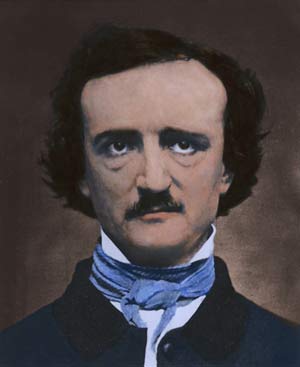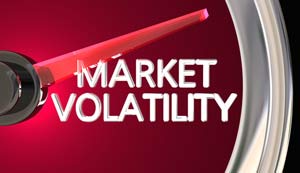As a writer, a Baltimore guy, and someone who loves horror fiction, I have a special affinity for Edgar Allen Poe, the master of macabre horror tales who wrote some of his best stuff here in Charm City. And one of my absolute favorites was an off-the-radar story called "A Descent into the Maelström."
Turns out, I'm not the only fan of this spine-tingler: D.R. Barton, Jr., a good friend and colleague who's also one of the top technical trading experts in the market today, also loves this tale.
But of course, we're not here for a Gothic fiction reading circle. We're out to make money - serious money.
And we mention "Maelström" because it turns out that this Poe short story is an almost perfect metaphor for the brand-new market "call" that D.R. is making.
Thanks to an array of converging "triggers," D.R. sees an abrupt and dramatic shift away from the largely "correction-free" bull market run that's allowed U.S. stocks to grind their way up to current stratospheric, record highs.
That shift, he says, will be followed by a period of whipsawing volatility unlike anything we've seen in years.
With downside market risk seeming to have taken a vacation in recent years, D.R. says investors have been lulled to sleep and are unprepared for what's to come.
That leaves them open to big losses - even ruinous ones. The unwary will be "treated" to a whipsaw market scarier than anything Poe ever dreamed up.
But, as was the case with the Poe short story, there's a strategy - a "secret" - for surviving the threat.
Folks who are in on it will not only "live to tell the tale," but they'll be able to cash in on what D.R. refers to as "one of the greatest trading windows" he's seen in years...
D.R.'s Monumental New Market Call
[mmpazkzone name="in-story" network="9794" site="307044" id="137008" type="4"]
During a visit to our offices here in Baltimore a week ago, D.R. and I sat down to talk about his bold new market prediction

Here's a partial transcript of our talk...
William Patalon, III: OK D.R., You and I have likened this prediction you're making to the Edgar Allan Poe "Maelström" tale - which is a personal favorite of mine. Let's start with the prediction itself - you know, the whys and wherefores. Then we'll explain the "literary" connection.
D.R. Barton, Jr.: (laughing) That's fine, Bill, that's great.
And since we're using the "Maelström" story, I'll stick with our water metaphor and start with a simple truth: Cheap money is like water - it's going to flow out somewhere and seek its own level.
WP: And by "cheap money," you're really talking about the strategies put to use by our policymaking friends at the U.S. Federal Reserve.
DRB: Exactly. Now, I'm vastly oversimplifying this - on purpose - but as the financial crisis of 2008 and 2009 deepened - deepened to the point that a lot of insiders were worried the entire financial system was about to slide off the edge and into oblivion - the Fed basically used two "tools" to stop that from happening.
The first tool was the interest rate. As we all know, the Fed slashed interest rates - the "price" of money - to all-time lows near 0.00%. And then it proceeded to hold rates down there for close to a decade.
The second tool was more complicated - but was essentially a case of the central bank pushing money into the economy.
![]()
WP: And creating liquidity.
DRB: (nodding) Creating liquidity.
The Fed did this by "buying" assets from banks and other investors - things like bonds, mortgage-backed securities (MBSs), and other debt instruments. Some of that debt was troubled - something the media referred to as "toxic."
WP: What we're talking mostly about here is "quantitative easing," the three rounds of which are known as QE1, 2, and 3. It's basically a situation where, early on, the central bank goes to a financial institution and says, "you give me your bonds, or unsellable paper, and I'll give you hard cash which you can then use to invest, lend, or make purchases with."
DRB: That's right, Bill. And it's actually even more powerful than that, since those early purchases had the central bank taking on assets no one wanted. That bolstered the strength of the financial institutions that had been holding all that stuff - and it infused cash into the financial system. The later QE rounds had the central bank buying bonds and MBSs on the open market.
By doing this, the Fed injected a whole bunch of liquidity into a financial system that was in bad shape. It's almost as if the central bank lubricated a machine that was overheating and about to seize up.
And the scale of this "easing" was gargantuan.
Before the Great Recession, the Fed had between $700 billion and $800 billion on its "balance sheet" - a lot of money, but nothing compared to what was to come. In November 2008, it started this whole "assets-for-cash" exchange by purchasing an additional $600 billion in MBSs - one of the instruments that helped create the crisis.
WP: And that was just the beginning. By March 2009 - when U.S. stocks bottomed and started a rebound - it held $1.75 trillion of bank debt, MBS debt, and U.S. Treasury paper. And this rose to $2.1 trillion by June 2010.
DRB: Right... the Fed started a second big round of "easing" that November [2010], and then did a third round in September 2012. The bottom line: By the time the central bank stopped buying assets in late October 2014, it had accumulated $4.5 trillion in assets.
WP: Meaning it had injected roughly that amount of cash into the global financial system.
DRB: Right... and the impact is clear.
The bear market lasted 17 months - less than average because of measures like this. Stocks lost 50% of their value. From the bottom, when the value of all U.S. stocks was about $12 trillion, American market wealth has zoomed to about $43 trillion today.
Remember my earlier comment about cheap money "squeezing out" somewhere?
Again, Bill, oversimplifying here, but we've had no inflation - one of the risks of cheap-money binges. Nor did we have any real "spikes" in GDP growth - one of the traditional goals of this kind of "prime-the-pump" infusions.
But all that cheap money did squeeze out - and created financial asset price inflation. And the second-longest bull market in history.
WP: So, sticking with our water metaphor here: All this cheap capital - from the low rates and the QE infusions - was like water pouring into a pond that lifted all the boats floating there.
DRB: Exactly, Bill. And that's a very important point to understand - because now, the Fed is reversing the process.
WP: In two ways.
DRB: Yes. First, it's raising rates. Indeed, it's already started doing so. That will raise the "price" of money, making it more expensive. That will continue to happen as Fed policymakers see a chance to do so.
Second, and more important for the scenario I'm talking about here, the Fed is now going to "unwind its balance sheet." That means it's basically going to "reverse the process" and get rid of the bonds, mortgage securities, and U.S. Treasuries it is holding. That will drain cash out of the system.
To use your analogy, the water that the Fed previously poured into the lake, raising all those investor boats... well, now it's draining that water off.

WP: Which brings us to our "Maelström" tale.
DRB: It does. And this is why I like this story as an example so much - it really doesn't get any better. A key point to understand here is that this "reversing the process" we're going to see from the Fed isn't going to have an orderly effect on the stock market.
It's going to be violent... whipsawing... volatile ...
WP: Violent... like a whirlpool...
DRB: (laughing) Precisely. I like this Poe story because the parallels with the stock market are eerie. And also because I'm a huge fan of the way Poe wrote - so his words not only told a story, but they also had a distinctive sound when read.
In the story, three fisherman...
WP: Three brothers...
DRB: Correct... three brothers... were sailing a 70-ton schooner off the coast of some islands where a gigantic maelström, or whirlpool - known as "The Ström" - was known to manifest itself. It was a great area for fishing, and they thought they'd be okay.
After their greatest day of fishing ever - talk about a parallel with the bull market, which gave investors the greatest haul of wealth ever - a storm blew up, seemingly out of nowhere.
WP: That unexpected storm... talk about another parallel to the markets.
DRB: Absolutely. So this storm blows up... and drives the ship toward the now-swirling maelström. They start making one circuit around "the belt" (the top of the funnel) after another, for over an hour. And then the ship started its trip into the maws of that "funnel."
And they were trapped. The crew tries to avoid the whirlpool, but can't - and the ship gets pulled in.
One brother - the youngest and least experienced and least prepared - gets washed overboard. He's gone. The other two - the narrator and his older brother - lash themselves to the deck.
So here's this ship, going round and round with the water, and sinking deeper and deeper into the watery funnel as it does so. But that's when the narrator remembers something he learned - a "secret" to surviving the whirlpool. He lashes himself to a barrel, which, because of its shape, will circle the "belt" but won't get sucked down.
He tries to get his brother to do the same, but his brother is so paralyzed with fear - so "locked up" - that he's frozen in place and can't. The narrator throws himself right into the whirlpool. And because he knows the secret, he lives - while his brother perishes.
WP: That's powerful ... and it lines up perfectly.
DRB: It does, Bill. It really does. Let's consider... the Fed is the storm that will alter our horizon. The violently reacting market is the whirlpool.
Investors who are frozen in place - who do nothing - will perish. They'll get sucked down. But investors who know the secret to surviving this looming whirlpool will survive - and will go on to do other things.
In fact, they'll get rich in the process.
WP: Because...
DRB: Because the market will shift from the current "grind-up" market we've been seeing to one that's super volatile... and whipsawing.
WP: And for a trader like you - a guy who employs the power of leverage granted by options - this is what the military would refer to as a "target-rich environment."
DRB: Exactly, Bill. In fact, I'll even say that this is the greatest trading window we've seen in years. I deal in emotion, psychology, probabilities, and the management of risk.

A market with a lot of volatility... a lot of action... gives us all that. If you'll pardon the expression, it's the "perfect storm" for a technical trader.
Here's why. After the second-longest bull market in history...
WP: ... or, using the story as our allegory, the greatest haul of fish investors have seen...
(both men laughing)
DRB: Right. Well, because of that "haul" - as well as the lack of meaningful visible risk - investors have become largely complacent. So when the storm comes, and the volatility appears, and the maelström swirls, they'll be unprepared - and scared. They'll become emotional, creating "extreme" opportunities that we can trade against for huge profits.
There will be big swings, from bearish to bullish to bearish again, and we can trade against that, too.
I mentioned probability. The fact that we've had a bull market that's lasted more than eight years makes it more probable than ever that we'll have a correction and the associated volatility that comes with it.
Finally, I mentioned risk management. We can trade against all the manifestations I mentioned. And we can use my proven risk-management tools to keep our profits - to maximize them and to minimize our losses.
WP: In short, like the narrator of the Poe story, we know the "secret" to surviving the whirlpool market. So investors who follow that secret will survive this market - and will go on to thrive.
DRB: That's it, Bill. As I said, this will be the greatest trading window we've seen in years. And I intend to capitalize - and to help my subscribers do so, as well. In a similar vein, Bill, I know that with your subscribers you've been using the "accumulate" strategy both to manage risk and to be opportunistic.
WP: But you're a trader by nature...
DRB: That's right. In both instances, though, we're talking about making adjustments. Facing change.
You know, Poe once wrote that "It is by no means an irrational fancy that, in a future existence, we shall look upon what we think [of as] our present existence, as a dream." This long bull market certainly has provided a dreamy - and profitable - existence for investors over these last eight-plus years. And, in the future, investors will certainly look back at this "present existence" as a dream. But that dream doesn't have to end - at least not for folks who adjust to the new reality I'm expecting.
WP: As always, this is good stuff. Thanks for sharing it, D.R.
DRB: And as always, you're quite welcome, Bill.
D.R. Barton, Jr. - one of the best "technicians" in the world - will be showing his 10-Minute Millionaire readers exactly how to trade the whirlpool of (expensive) volatility that's coming courtesy of Yellen & Co. Click here to get totally free access to his expert techniques and every single one of his trading recommendations, three times a week. What's more, you'll get first crack at D.R.'s new book, "The 10-Minute Millionaire: The One Secret Anyone Can Use to Turn $2,500 into $1 Million or More."
Follow Bill on Facebook and Twitter.
About the Author
Before he moved into the investment-research business in 2005, William (Bill) Patalon III spent 22 years as an award-winning financial reporter, columnist, and editor. Today he is the Executive Editor and Senior Research Analyst for Money Morning at Money Map Press.



